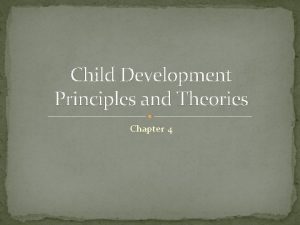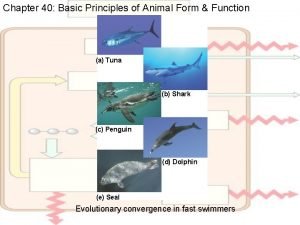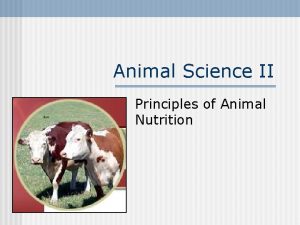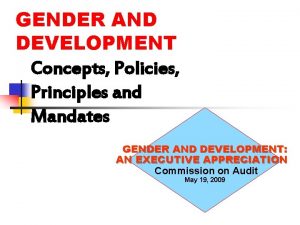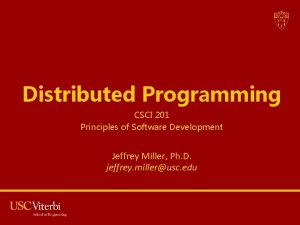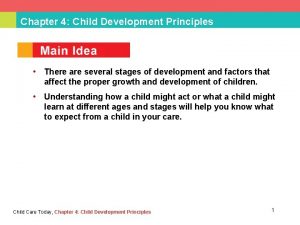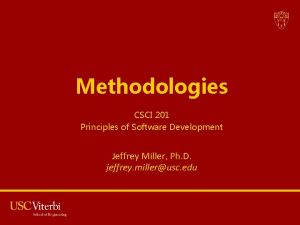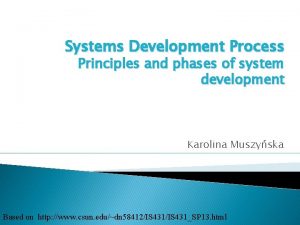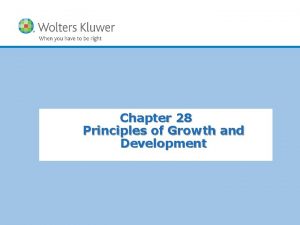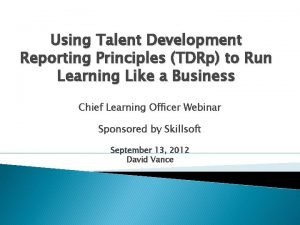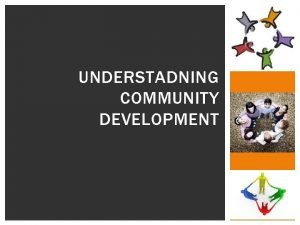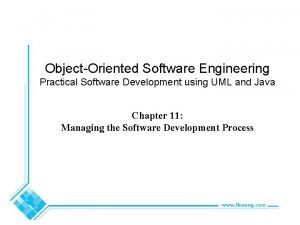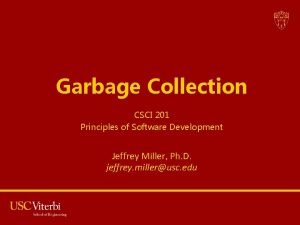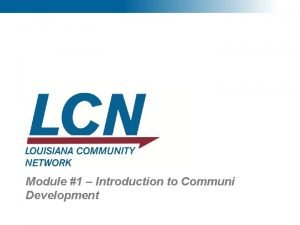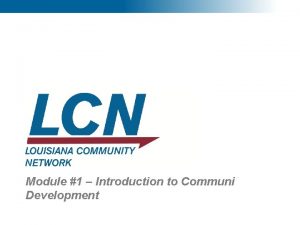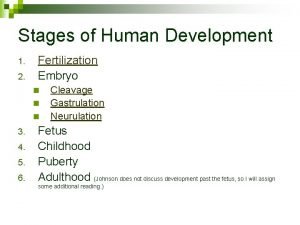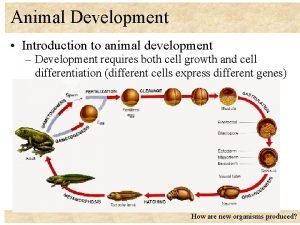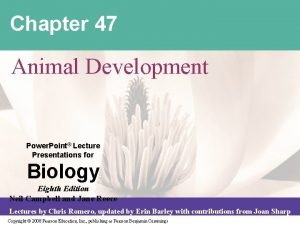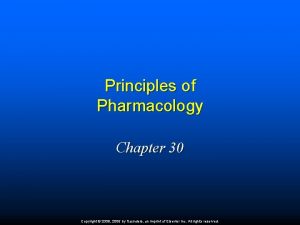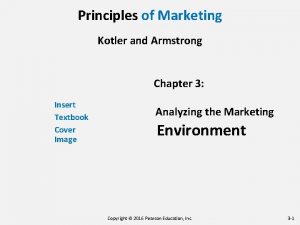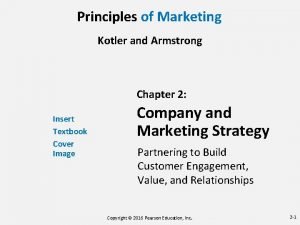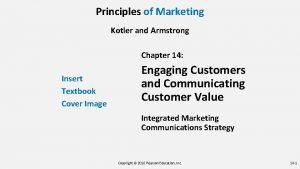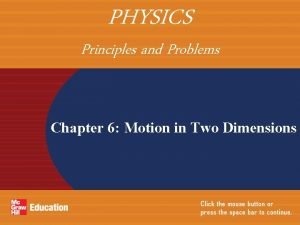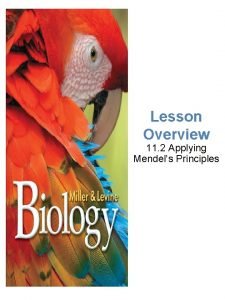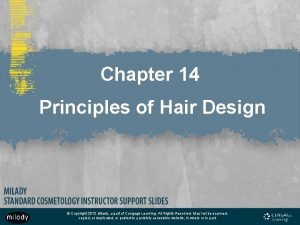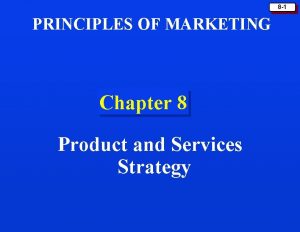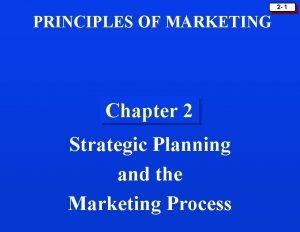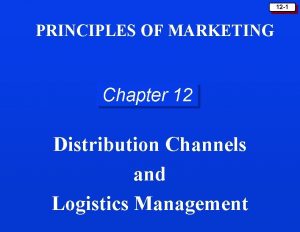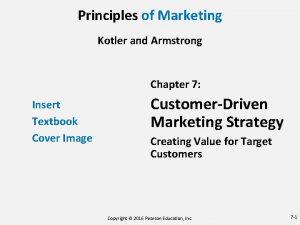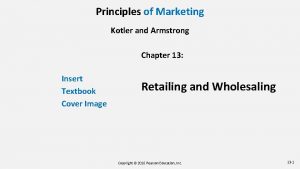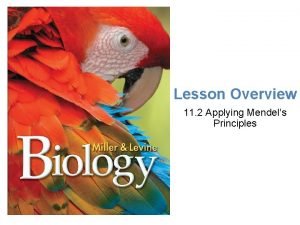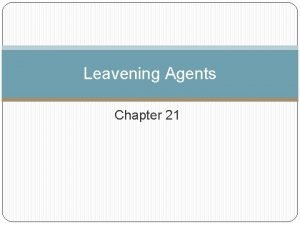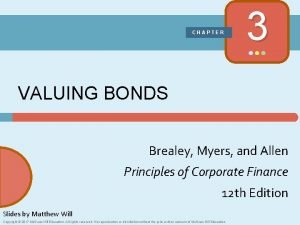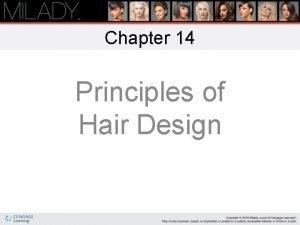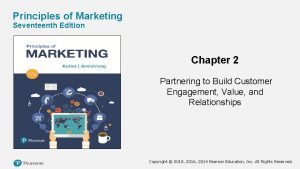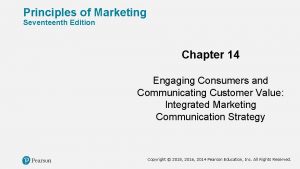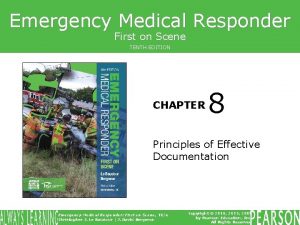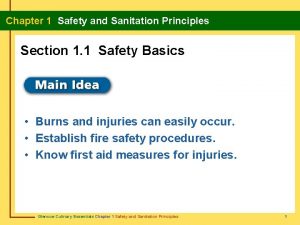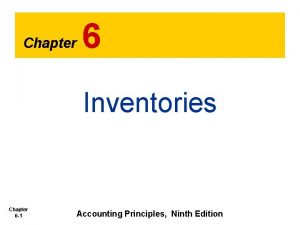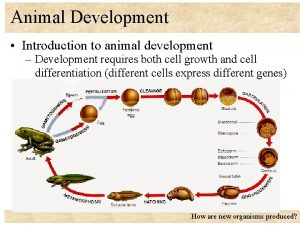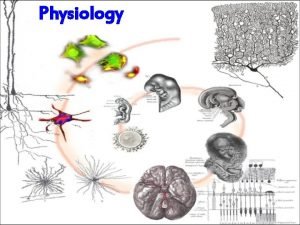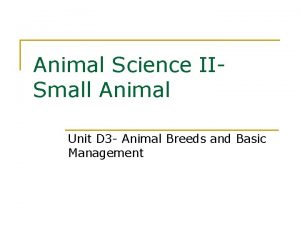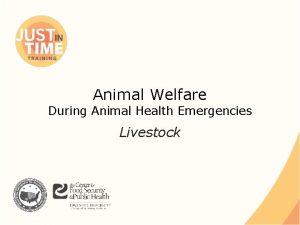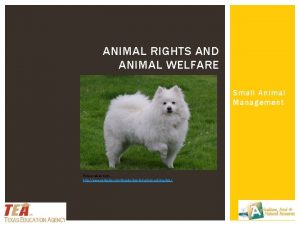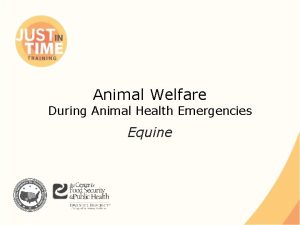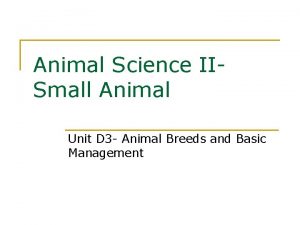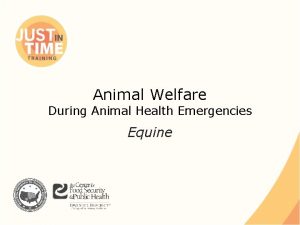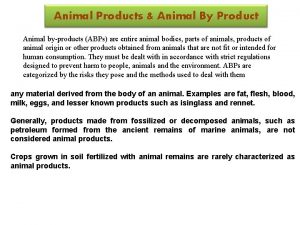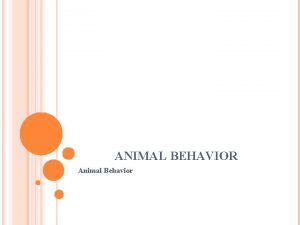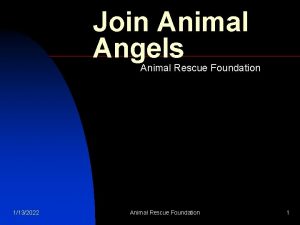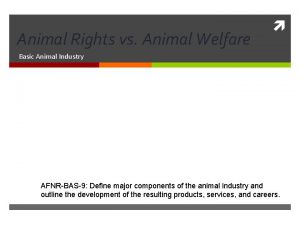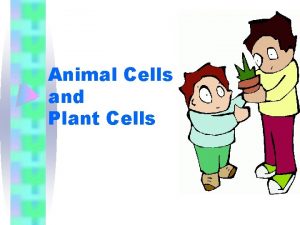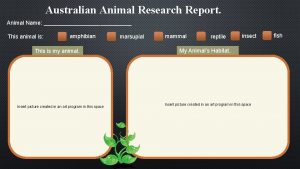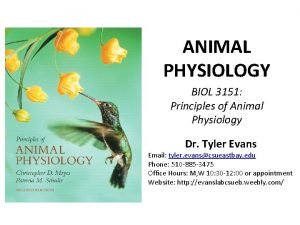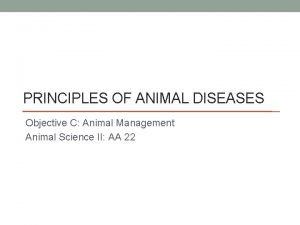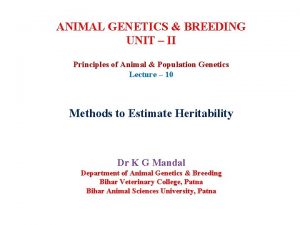Animal Development Chapter 42 Principles of Animal Development








































































- Slides: 72

Animal Development Chapter 42

Principles of Animal Development? Development – where multicellular organisms grow and increase in organization and complexity ◦ Development begins with a fertilized egg and ends with a sexually mature adult Three principle mechanisms: ◦ Individual cells multiply ◦ Some of their daughter cells differentiate, or specialize in both structure and function ◦ As they differentiate, groups of cells move and become organized into multicellular structures

From identical to differentiated All of the cells of an individual animal’s body are genetically identical in an animal’s body, How can they differentiate into different structures with distinct functions? The solution is that different genes in different places and at different times in an animal’s body, are active.

Indirect and Direct Development Baby mammals and reptiles are miniature versions of the adults of their species, undergoing direct development The majority of animals species undergo indirect development - the newborn has a very different body structure than the adult

Indirect Development Animals undergo a radical change in body form Amphibians - frogs and toads, most invertebrates Females produce huge numbers of eggs, each containing a small amount of food reserve called yolk The yolk nourishes the developing embryo until it hatches into a small, sexually immature feeding stage called a larva Parents provide these vulnerable offspring with neither food or protection from predators, most die in their larval stage After feeding for weeks to years, a handful of survivors undergo a revolution in body form - metamorphosis, and become sexually mature adults

Butterflies and Larvae Most larvae look very different from adults, but also play different roles in their ecosystems Most adult butterflies sip nectar from flowers and unintentionally pollinate the flower in return Their caterpillar larvae munch on leaves, often of specific host plants

Cicadas We regard the adult form as the “real animal” and the larval stage as “preparatory” Most of the life span of some animals – insects - is spent in the larval form North American periodical cicadas spend 12 - 16 years as underground larvae, sucking juices from plant roots, and only 4 -6 weeks as adults,

Direct Development Newborn animals resemble miniature adults Snails and fish, all mammals, reptiles (including birds), undergo direct development As the young animal matures, it may grow bigger, but does not fundamentally change its body form

Two Direct Development Strategies Juveniles are typically much larger, so they need more nourishment before emerging into the world Two strategies have evolved that meet the embryo’s food requirement: ◦ Birds, most reptiles, and a few fish produce eggs that contain large amounts of yolk ◦ Mammals, snakes, and a few fish have little yolk in their eggs, embryos are nourished within the mother’s body

Thank your mom Providing food for directly developing embryos places great demands on the mother ◦ Many offspring, - of birds and mammals - require additional care and feeding after birth, placing additional demands on one or both parents ◦ Relatively few offspring are produced, but a higher proportion reach adulthood, because the parents devote more resources to each individual Most of the mechanisms of development—the control of gene expression to allow differentiation of individual cells and entire body parts—are fundamentally similar in vertebrates and invertebrates, and in animals with indirect or direct development

Cleavage of the Zygote Cleavage of the zygote begins development The formation of an embryo begins with cleavage – a series of mitotic cell divisions of the fertilized egg or zygote The cell zygote is a large

Morula During cleavage, there is little or no cell growth between cell divisions As cleavage progresses, the available cytoplasm is split up into ever smaller cells that gradually approaches the size of cells in the adult Eventually a solid ball of small cells, the

Blastula A cavity opens within the morula and the cells become the outer covering of a hollow structure, the blastula The details of cleavage differ by species and are partly determined by the amount of yolk, which hinders cytokinesis ◦ Eggs with large yolks (hen’s egg) don’t divide all the way through; nevertheless ◦ In birds and other reptiles, the blastula is flattened on top of the yolk

Gastrula The location of cells on the surface of the blastula forecasts their developmental fate in the adult Gastrulation begins when a dimple - the blastopore forms on one side of the blastula ◦ Surface cells migrate through the blastopore in a continuous sheet ◦ The resulting indentation enlarges to form a cavity that will become the digestive tract

Gastrulation The migrating cells form three tissue layers in the embryo ◦ Cells that move through the blastopore to line the future digestive tract are called endoderm, it also forms the respiratory tract lining, liver and pancreas ◦ The cells remaining on the outside form the ectoderm and form surface structures such as skin, hair, nails, and nervous system ◦ Cells that migrate between the endoderm and ectoderm form the third layer, - mesoderm which forms structures between these two, the muscles, skeleton, and circulatory systems

Gastrulation in the Frog

Animation: Overview of Animal Development

Organogenesis Adult structures develop during organogenesis Organogenesis - development of adult structures from embryonic tissue layers Two major processes: 1. A “master switch” genes turn on and off, each controlling the transcription and translation of the genes involved in producing each structure 2. Organogenesis prunes away excess cells

Organogenesis This sculpting requires death of excess cells Embryonic than adults vertebrates have more motor neurons ◦ Embryonic motor neurons are programmed to die unless they form a synapse with a skeletal muscle, which releases a chemical that prevents the death of the neuron All amphibians, reptiles, and mammals pass through embryonic stages in which they have tails and webbed fingers and toes ◦ In humans, these stages appear during the fourth to seventh weeks of development ◦ A few weeks later, the cells of the tail and webbing die; the tail disappears, and the hands and feet have separated

Extraembryonic Membranes Development in reptiles and mammals depends on extraembryonic membranes ◦ Fish live and reproduce in water, by spawning ◦ Amphibians spend adult lives on land, lay their eggs in water ◦ In both, the embryo obtains nutrients from the yolk of the egg, oxygen from water, and releases its wastes into water Terrestrial vertebrate life was not possible until the evolution of the amniotic egg ◦ First in reptiles, persists today in reptiles, birds and their descendents, the mammals ◦ It allows these groups to complete their development in their own “private pond”

The Amniotic Egg The amniotic egg is characterized by four extraembryonic membranes – ◦ The chorion, amnion, allantois, yolk sac ◦ In reptiles ◦ The chorion lines the shell and exchanges O 2 and CO 2 between the embryo and the air ◦ The amnion encloses the embryo in a watery environment ◦ The allantois stores and isolates wastes ◦ The yolk sac contains the yolk


Placental Mammals In placental mammals—except marsupials —the embryo develops within the mother’s body until birth ◦ Marsupials - Kangaroos and monotremes (platypuses) ◦ All four extraembryonic membranes are essential for development


Differentiation of Cells A zygote contains all genes needed to produce an entire animal ◦ Every cell of the body contains all of these genes —that makes cloning possible ◦ In any given cell some genes are expressed, others are not The differentiation of cells during development happens because of differences in gene expression

Controlling Gene Expression Cells have ways of controlling gene expression, ie regulating which genes are transcribed into m. RNA ◦ Transcription factors bind to DNA near the promotor regions, where gene transcription begins ◦ Different transcription factors bind to different genes and turn their transcription on or off ◦ Which genes are transcribed determines the structure and function of the cell ◦ This leads to one of the central questions about development: What causes different cells to transcribe different genes?

Animal Development Molecules positioned in the egg and produced by nearby cells control gene expression during embryonic development ◦ In animal embryos, the differentiation of individual cells and the development of entire structures are driven by one or both of two processes: The actions of gene-regulating substances inherited from the mother in her egg Chemical communication between the cells of the embryo

Maternal Molecules in the Egg May direct early embryonic differentiation All of the cytoplasm in a zygote was in the egg before fertilization, sperm only contributed a nucleus In most invertebrates and some vertebrates, specific m. RNA and protein molecules are concentrated in different places in the egg’s cytoplasm during oogenesis Some of these proteins are transcription factors that regulate which genes are turned on and off

How cells divide is important During the first cleavage divisions after fertilization, the zygote and daughter cells divide at specific places and orientations As a result, these cells receive different maternal m. RNAs and transcription factors So, different cells transcribe different genes, start differentiating into distinct cell types and ultimately give rise to specific structures The positioning of maternal molecules in some eggs so strongly controls development, that the egg can be mapped according to the major structures that will be produced by daughter cells inheriting each section of cytoplasm

A “Fate Map” of the Sea Squirt Egg

Mammal Embryos In mammal embryos, current evidence indicates that all cells formed during cleavage are functionally equivalent ◦ Which cells give rise to which parts of the embryo appears to be a matter of chance, depending where the cells happen to be located during the transition from the morula to the blastocyst

Chemical Communication Regulates embryonic development Induction - in animal embryos, the developmental fate of each cell is determined by chemical interactions between cells ◦ Cells release chemical messengers that alter the development of other, nearby cells ◦ Specific groups of genes are selectively activated in the recipient cells, causing them to differentiate In amphibian embryos, a cluster of cells near the blastopore, called the organizer, determines whether nearby cells will become ectoderm or mesoderm and where the head and nervous system will form

Organizer Proteins ◦ Organizer proteins interact with other messengers to stimulate or repress the expression of genes in nearby cells, often genes that encode transcription factors and that therefore exert widespread effects on gene expression ◦ Which genes are expressed determines the structures and functions of the cells ◦ As these cells differentiate, they release other chemicals that alter the fate of still other cells, in a cascade that culminates in the development of the tissues and organs of the adult body

Homeobox Genes Regulate body development of entire segments of the ◦ Although their functions differ in different animals, homeobox genes code for transcription factors that regulate the transcription of many other genes ◦ Each homeobox gene has major responsibility for the development of a particular region in the body ◦ Homeobox genes were discovered in fruit flies, where specific mutations cause entire parts of the body to be duplicated, replaced, or omitted For example, one mutant homeobox gene causes the development of an extra body segment, complete with an extra set of wings ◦ Homeobox genes are arranged in a head-to-tail order

Fruit Fly Homeobox Genes ◦ Early in development, homeobox genes are transcribed in a specific sequence within the animal body ◦ “head” homeobox genes are transcribed in the anterior part of the embryo, “tail” homeobox genes are transcribed in the tail

How Do Humans Develop? Controlled by the same mechanisms as in the development of other animals Differentiation mo. and growth are rapid for the first 2 ◦ A human egg is usually fertilized in the uterine tube and undergoes a few cleavage divisions there, becoming a morula on its way to the uterus ◦ By the 5 th day after fertilization, the zygote has developed into a hollow ball of cells, known as a blastocyst (mammalian version of a blastula) A blastocyst is an outer layer of cells surrounding a cluster of cells called the inner cell mass; the outer cell layer becomes the chorion The outer cell layer attaches to, then burrows into the endometrium of the uterus, = implantation

The Journey of the Egg day 3 (b) An egg within the uterine tube day 2 day 4 day 1 4 cells 2 cells morula day 7 blastocyst inner cell mass of blastocyst zygote Fertilization occurs within the uterine tube embryo sperm day 0 The blastocyst implants in the uterus ovary ovulated egg muscle layer endometrium (a) The first week of development uterine wall

Animation: Fertilization

Week 1 The chorion and endometrium form the placenta ◦ The chorion secretes chorionic gonadotropin (CG), which prevents the death of the corpus luteum ◦ The corpus luteum sustains pregnancy by secreting progesterone and estrogen for the first couple of months, until the placenta takes over All the cells of the inner cell mass have the potential to develop into any type of tissue ◦ This allows the inner cell mass to produce the entire embryo and the three remaining extraembryonic membranes ◦ The inner cell mass is also the source of human embryonic stem cells, may be used to replace damaged adult tissues

A Blastocyst Implants outer cell layer (future chorion) cavity inner cell mass endometrium (uterine lining) (a) Early blastocyst yolk sac chorion embryonic disk (future embryo) endometrium amniotic cavity amnion (b) Late blastocyst

Week 2 After implantation, two cavities form and gastrulation occurs ◦ During the 2 nd week, the inner cell mass grows and splits, forming two fluid-filled sacs that are separated by a double layer of cells called the embryonic disk One layer of cells is continuous with the yolk sac, in placental mammals it contains no yolk The second layer of cells is continuous with the amnion

Week 3 ◦ Gastrulation begins near the end of the 2 nd after fertilization, and is usually complete by the end of the 3 rd week The two layers of the embryonic disk separate slightly, and a slit forms in the cell layer on the “amnion side” of the disk Cells migrate through the slit into the interior of the disk, forming mesoderm, endoderm, and the fourth extraembryonic membrane, the allantois The cells remaining on the surface become ectoderm

3 -4 weeks 3 rd week, the embryo begins to form the spinal cord and brain The heart expands and becomes muscular, starts to beat at the beginning of the 4 th week During the 4 th week, embryo bulges into the uterine cavity, bathed in fluid contained within the amnion The umbilical cord forms from the fusion of the yolk sac to the embryonic digestive tract The body stalk contains the allantois, which contributes the blood vessels that will become the umbilical arteries and vein The umbilical cord now connects the embryo to the placenta, which has formed from the merger of the chorion of the embryo and the lining of the uterus

Human Development in the 4 th Week location of the developing embryo in the uterus chorion embryo placenta chorionic villi body stalk yolk sac amnion form the umbilical cord

4 -7 weeks ◦ During the 4 th and 5 th weeks, the embryo develops a tail and pharyngeal (gill) grooves These structures are reminders that we share ancestry with other vertebrates that retain their gills in adulthood In humans they disappear as development continues ◦ By the 7 th week, the embryo has rudimentary eyes, a rapidly developing brain; the webbing between fingers and toes is disappearing

A 5 -Week-Old Human Embryo pharyngeal grooves 8 mm arm bud heart eye leg bud tail umbilical cord brain

2 months At the end of the 2 nd month, nearly all major organs have begun to develop ◦ Structures like the arms and legs are recognizably human ◦ The gonads appear and develop into testes or ovaries The first two months of pregnancy are a time of rapid differentiation and growth for the embryo and a time of danger ◦ Although vulnerable throughout development, the rapidly developing organs are extra sensitive to toxic substances Sex hormones are secreted. These hormones affect future development of the embryo - the reproductive organs, brain and other parts of the body

An 8 -Week-Old Human Embryo 30 mm umbilical cord placenta amniotic sac

The last 7 months Growth and development continues ◦ The brain continues to develop rapidly and the head remains disproportionately large ◦ The lungs, stomach, intestine, and kidneys enlarge and become functional, although they will not be used until after birth As the brain and spinal cord grow, they begin to generate behaviors ◦ As early as the 3 rd month of pregnancy, the fetus can move and respond to stimuli ◦ Some instinctive behaviors appear, such as sucking

Premature Births Nearly all fetuses 32 weeks or older can survive outside the womb with some medical assistance Heroic measures can often save infants born as early as 26 weeks, although more mature fetuses have a much greater chance of healthy survival

A Calender of Development from Zygote to Birth week 1 week 2 week 3 week 4 zygote to late blastocyst week 5 week 6 0. 32– 0. 43 inch (8– 11 mm) embryo blastocyst zygote morula Cleavage of zygote forms the morula and then the blastocyst, which implants in the uterus. late blastocyst The blastocyst burrows into the endometrium; forms the yolk sac, amnion, and embryonic disk. 0. 06– 0. 1 inch (1. 5– 2. 5 mm) 0. 12– 0. 20 inch (3– 5 mm) 0. 28– 0. 35 inch (7– 9 mm) Gastrulation occurs; the notochord and beginning of the neural tube form. The neural tube closes; arm buds, tail, and pharyngeal (gill) grooves form; the heart beats. The eyes begin to form; leg buds form; the brain enlarges. External ears and webbed fingers form; the pharyngeal (gill) grooves and tail are disappearing.

A Calender of Development from Zygote to Birth week 7 week 8 week 10 embryo week 12 week 16 fetus 0. 67– 0. 79 inch (1. 7– 2. 0 cm) 0. 90– 1. 10 inches (2. 3– 2. 8 cm) Webbed toes form; bones begin to stiffen; the back straightens; the eyelids begin to form. All the major organs begin to form; the arms can bend; fingers are distinct. Facial features and outer ears take shape. 1. 25– 1. 75 inches (3. 2– 4. 4 cm) After 8 weeks, the embryo is called a fetus. Red blood cells form; toes separate; eyelids have developed; major brain parts are present; the hands can form fists. 2– 3 inches (5– 7. 6 cm) The neck is well defined; all organs are present; male or female genitals are present; arms and legs move; teeth begin to form; a heartbeat can be detected electronically. 4– 5 inches (10. 2– 12. 7 cm) Sucking and swallowing movements occur; the liver and pancreas begin functioning. The body has grown relative to the head; major organs continue developing. The mother may feel movement; weight is about 5 oz.

A Calender of Development from Zygote to Birth week 20 week 24 week 30 week 36 fetus 6– 7 inches (15. 2– 17. 8 cm) The fetus may suck its thumb; arms and legs can punch and kick; the body can change position. Fingernails are formed; fat is deposited under the skin; eyebrows and eyelashes appear. 8– 9 inches (20. 3– 22. 9 cm) Brain development continues, hearing develops, and the eyes can move. The fetus can hiccup, squint, smile, and frown. The fetus may have hair on its head. Unique footand fingerprints appear. Weight is about 1– 1. 5 pounds. 15– 16 inches (38. 1– 40. 6 cm) Brain development continues; the eyes open and close and see light; the fetus kicks and stretches. Breathing movements occur but the lungs are not mature. Bones are present but flexible. The baby may survive if born. 16– 19 inches (40. 6– 48. 3 cm) Eyes open and close corresponding to wake and sleep cycles; body fat increases; lungs and other organs are functional. The child can grasp and orient toward light. Weight is about 5– 6 pounds, and the child is no longer considered premature if born. Full term is 38 weeks.

The Placenta and Nutrient Exchange The placenta exchanges materials between mother and embryo ◦ During the first days after implantation, the embryo obtains nutrients directly from the endometrium ◦ During the following week, the placenta begins to develop from the interlocking structures produced by the embryo and the endometrium ◦ The outer layer of the blastocyst forms the chorion, which grows fingerlike chorionic villi that extend into the endometrium

Blood Flow of the Placenta Blood vessels of the umbilical cord connect the embryo’s circulatory system with a dense network of capillaries in the villi Implantation erodes some of the blood vessels of the endometrium, producing pools of maternal blood that bathe chorionic villi The embryo’s blood and the mother’s blood remain separated by the walls of the villi and their capillaries, so the two blood supplies do not mix This permits many small molecules to move between the mother’s and embryo’s blood

What moves between embryo and mother ◦ Oxygen diffuses from the mother to the embryo ◦ Nutrients, aided by active transport, travel from the mother to the embryo ◦ CO 2 and wastes diffuse from the embryo to the mother blood ◦ The membranes of the capillaries and chorionic villi act as barriers to some substances, including large proteins and cells ◦ Some disease-causing organisms and harmful chemicals, like alcohol, can penetrate the placenta

The Placenta placenta maternal venule fetal umbilical vein chorionic fetal villi capillaries umbilical cord fetal umbilical arteries endometrium maternal arteriole (amniotic fluid) (pool of maternal blood) amnion fetal chorion uterine muscle

The Placenta Secretes Hormones By the end of the first trimester, the placenta secretes estrogen and progesterone, enough to sustain its own growth and development At this time, the corpus luteum degenerates ◦ These hormones stimulate development of the mammary glands ◦ Progesterone also inhibits premature contractions of the uterine muscles

Labor and Delivery The fetus positions head down in the uterus, with the crown of the skull resting against the cervix Childbirth begins around the end of the 9 th month Birth results from a complex interplay between: ◦ Uterine stretching caused by the growing fetus ◦ Maternal and fetal hormones trigger labor, contractions of the uterus result in delivery ◦ Unlike skeletal muscles, smooth muscle of the uterus can contract spontaneously, stretching enhances their tendency to contract The uterine muscles occasionally contract before delivery ◦ No one knows what triggers labor in humans, but chemical signals from the placenta and maturing fetus may be involved

◦ Whatever the initial stimulus, the placenta releases prostaglandins, which make the uterine muscles more likely to contract As the uterus contracts, it pushes the fetus’ head against the cervix, stretching it This has two effects: The cervix expands so the fetus’ head can fit Second, stretching the cervix sends signals to the mother’s brain, causing release of oxytocin

Its positive feedback ◦ Oxytocin stimulates contractions of the uterine muscles, pushing the baby harder against the cervix, which stretches further, causing still more oxytocin to be released ◦ This positive feedback cycle continues until the baby emerges ◦ After a brief rest following childbirth, the uterus resumes its contractions and shrinks ◦ ◦ During these contractions, the placenta is separated from the uterine wall and expelled

Human Childbirth 1 The baby orients head downward, facing the mother’s side; the cervix begins to thin and expand in diameter (dilate) 2 The cervix dilates completely to 10 centimeters (almost 4 inches wide), and the baby’s head enters the vagina, or birth canal; the baby rotates to face the mother’s back 3 The baby’s head emerges 4 The baby rotates to the side once again as the shoulders emerge

Cutting the Cord The umbilical cord releases prostaglandins that cause the muscles surrounding fetal blood vessels in the umbilical cord to contract and shut off blood flow Although tying off the umbilical cord is standard practice, it is not necessary; if it were, other mammals would not survive birth

Milk Secretion Stimulated by the hormones of pregnancy ◦ Large quantities of estrogen and progesterone are secreted by the placenta Acting together with other hormones, they stimulate the milk-producing mammary glands in the breasts to grow, branch, and develop the capacity to secrete milk ◦ The mammary glands are arranged in a circle around the nipple, each with a milk duct leading to the nipple

The Structure of the Mammary Gland muscle fat suspensory ligaments mammary glands milk duct nipple

Lactation ◦ Prolactin, anterior pituitary gland, promotes both mammary gland development and the actual secretion of milk, lactation ◦ Prolactin release is stimulated by high levels of estrogen produced by the placenta, so you might think that milk secretion would begin even before childbirth ◦ However, lactation is inhibited by progesterone, also secreted by the placenta During childbirth the placenta is ejected Progesterone levels plummet, allowing prolactin to cause lactation

Milk Production The infant’s suckling stimulates nerve endings in the nipples, which signal the hypothalamus to cause the pituitary gland to release an extra surge of prolactin and oxytocin and milk is released ◦ Oxytocin causes muscles surrounding the mammary glands to contract, ejecting the milk into the ducts that lead to the nipples ◦ The prolactin surge stimulates rapid milk production for the next feeding The first few days after birth, the mammary glands secrete a yellowish fluid called colostrum High in protein and contains antibodies Is gradually replaced by mature milk, which is higher in fat and milk sugar (lactose) and lower in protein

Aging, the Final Stage of Human Development Aging - accumulation of damage to biological molecules, particularly DNA the nucleus and mitochondria, results in defects in cell functioning, declining health, and death ◦ This damage from natural errors in DNA replication, radiation, chemicals in food, cigarettes, and industrial products—begins at fertilization ◦ Many biological molecules are harmed by free radicals, some produced by environmental pollutants, but most by energy-generating reactions in our cells, especially in mitochondria ◦ Some molecular injury can be tolerated Young bodies may be able to repair damage or compensate As an individual ages, its repair abilities diminish; eventually the body’s tolerance for damage is exceeded

Aging is manifested in many ways Muscle and bone mass is lost Skin elasticity decreases Reaction Senses, acute time slows such as vision and hearing, become less A less-robust immune response renders the aging individual more vulnerable to disease Eventually, the individual can no longer fight off natural assaults, and dies

Youth Meets Age

How old is OLD? For thousands of years, people have attempted to delay aging and extend life span ◦ Modern care can prevent or cure many diseases and can fix or replace some damaged organs ◦ ◦ Some dietary changes, particularly not eating very much food can prolong life, at least in animal experiments However the maximum human life span,

Evolutionary Hypotheses Evolutionary unavoidable hypotheses suggest that aging is Natural selection favors organisms that leave the largest number of healthy, successful offspring Even a hypothetically immortal animal that wouldn’t die from “inside” so to speak, will eventually succumb to predation, accident, or disease ◦ Perhaps natural selection favors devoting more of the body’s resources to reproduction than to the continuous bodily repair required for immortality ◦ The fact that humans can live so long after they stop reproducing is probably evidence of the selective advantage conferred by the care and teaching given to the young by their elders
 Child development principles and theories answer key
Child development principles and theories answer key Homeostasis animal
Homeostasis animal Basic principles of animal form and function
Basic principles of animal form and function Principles of animal nutrition
Principles of animal nutrition Animal vs plant cell venn diagram
Animal vs plant cell venn diagram Plant vs animal cells venn diagram
Plant vs animal cells venn diagram Similarities between animal rights and animal welfare
Similarities between animal rights and animal welfare Theories about
Theories about Gender and development concepts
Gender and development concepts 201 principles of software development pdf
201 principles of software development pdf What are the 4 principles of child development
What are the 4 principles of child development Principles of recipe development
Principles of recipe development Csci 201
Csci 201 Management contribution phase
Management contribution phase Principles of system development
Principles of system development Principles of growth and development
Principles of growth and development Talent development reporting principles
Talent development reporting principles Steps in community development
Steps in community development Principles of growth
Principles of growth Early childhood and middle childhood
Early childhood and middle childhood Csci201
Csci201 Community development principles
Community development principles Community development principles
Community development principles Animal pole
Animal pole Stages of animal development
Stages of animal development Animal development ppt
Animal development ppt Chapter 30 principles of pharmacology
Chapter 30 principles of pharmacology Chapter 7 marketing
Chapter 7 marketing Chapter 5 principles of marketing
Chapter 5 principles of marketing Chapter 3 principles of marketing
Chapter 3 principles of marketing Chapter 2 principles of marketing
Chapter 2 principles of marketing Communication process
Communication process Chapter 6 assessment physics
Chapter 6 assessment physics Chapter 12 lesson 2 applying mendels principles
Chapter 12 lesson 2 applying mendels principles Chapter 12 lesson 2 applying mendels principles
Chapter 12 lesson 2 applying mendels principles Chapter 8 lesson 1 principles of the constitution answers
Chapter 8 lesson 1 principles of the constitution answers Chapter 5 principles of voice leading answers
Chapter 5 principles of voice leading answers Chapter 5 principles of engine operation
Chapter 5 principles of engine operation Chapter 28 unemployment problems and applications answers
Chapter 28 unemployment problems and applications answers Chapter 2 principles of ecology
Chapter 2 principles of ecology Principles of ecology 1 organisms and their relationships
Principles of ecology 1 organisms and their relationships Principles of ecology chapter 2
Principles of ecology chapter 2 List the five principles of hair design
List the five principles of hair design Chapter 12 lesson 2 applying mendels principles
Chapter 12 lesson 2 applying mendels principles Product line decisions
Product line decisions Principle of marketing chapter 2
Principle of marketing chapter 2 Principles of marketing chapter 12
Principles of marketing chapter 12 Principles of marketing chapter 3
Principles of marketing chapter 3 Principles of marketing chapter 1
Principles of marketing chapter 1 Principles of marketing chapter 7
Principles of marketing chapter 7 Principles of marketing chapter 13
Principles of marketing chapter 13 Principles of marketing chapter 9
Principles of marketing chapter 9 Chapter 12 lesson 2 applying mendels principles
Chapter 12 lesson 2 applying mendels principles Leavening agents
Leavening agents Principles of corporate finance chapter 3 solutions
Principles of corporate finance chapter 3 solutions List the five principles of hair design
List the five principles of hair design One of the ten principles of economics in chapter 1
One of the ten principles of economics in chapter 1 Chapter 2 principles of marketing
Chapter 2 principles of marketing Principles of marketing chapter 17
Principles of marketing chapter 17 Principles of marketing chapter 14
Principles of marketing chapter 14 Principles of instrumental analysis chapter 1 problem 8qp
Principles of instrumental analysis chapter 1 problem 8qp Chapter 4 study guide physics principles and problems
Chapter 4 study guide physics principles and problems Chapter 2 representing motion assessment answers
Chapter 2 representing motion assessment answers Chapter 8 principles of effective documentation
Chapter 8 principles of effective documentation Chapter 2 section 1 organisms and their relationships
Chapter 2 section 1 organisms and their relationships Chapter 1 safety and sanitation principles
Chapter 1 safety and sanitation principles Chapter 1 principles of government
Chapter 1 principles of government One of the ten principles of economics in chapter 1
One of the ten principles of economics in chapter 1 Ten principles of economics chapter 1
Ten principles of economics chapter 1 Psychology principles in practice chapter 1
Psychology principles in practice chapter 1 Principles of government chapter 1
Principles of government chapter 1 Mktg 12 principles of marketing
Mktg 12 principles of marketing Chapter 6 inventories
Chapter 6 inventories
